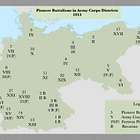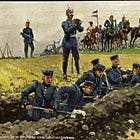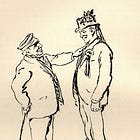During the first week of August of 1914, in the course of the pre-planned activation of active and Reserve formations, the armies of the German Empire mobilized one-hundred and thirty-eight active and sixty Reserve pioneer companies.1 Of these one-hundred and ninety eight companies, one hundred and seventeen reported for duty with infantry divisions (whether active or Reserve), fifty-four belonged to fortress pioneer regiments, and twenty-seven served in the field battalions assigned to the garrisons of fortresses.
As the active and Reserve companies marched to war organized, the soldiers left behind organized a thirty-five replacement battalions [Ersatz Bataillone]. These, which set up housekeeping in the barracks formerly occupied by their peacetime progenitors, formed fourteen mobile Ersatz companies.2 Of these, twelve companies served with with mixed Ersatz brigades on the Western Front. The other two served with the Landwehrkorps in East Prussia.)3
At the same time, each of the replacement battalions affiliated with an ordinary pioneer battalion formed one or two Landwehr pioneer companies. Thirty of these received a full allowance of horses and wagons, thereby earning the designation of mobile Landwehr Pionier Kompanie. Fourteen, known as immobilen Landwehr Pionier Kompanien, made do with a handful of less capacious carts and a much smaller number of quadrupeds.4
During the first week or so of mobilization, the replacement battalions of fortress pioneer battalions formed no Landwehr companies at all. One possible reason for this was the assignment of older men might otherwise serve in Landwehr companies to the siege trains [Pionier Belagerungstrains] of the fortress pioneer regiments. (Each pioneer siege train rated twice as many men as a pioneer company.)5
Note:
For Further Reading:
In a table published in his Honor Book of German Pioneers, Major Heinrici counts one-hundred and forty active pioneer companies took the field at the start of the war. Elsewhere in that book, however, he writes that, on the eve of mobilization, two of the Bavarian peacetime pioneer battalions, the K.B. 1. Pionier Bataillon and the K.B. 3. Pionier Battalion, lacked fourth companies. The absence of such companies accords with the orders of battle for the four Bavarian army corps on 18 August 1914 appended to the first volume of the German official history. Paul Heinrici Das Ehrenbuch der Deutschen Pioniere (Berlin: Wilhelm Kolk, 1932) pages 58, 61 and 62 Reichsarchiv Die Grenzschlachten im Westen (Berlin: E.S Mittler, 1925) pages 678-680
Ersatz battalions of peacetime pioneer battalions located in places other than East Prussia and regions bordering France raised complete Ersatz pioneer companies. Others formed detachments that reinforced understrength companies raised by other Ersatz battalions.
Die Grenzschlachten im Westen pages 683-685 and Reichsarchiv Die Befreiung Ostpreußens (Berlin: E.S. Mittler, 1925) page 363
Heinrici Ehrenbuch, page 62
Herman Cron Imperial German Army, 1914-1918: Organization, Structure, Orders-of-Battle (Solihull: Helion, 2002) pages 155 and 171












The more I think about it, the more I'm convinced we need to return to WWI troop types. Sweeping cavalry charges, massed cannon fire, sabers, swords, and armored infantry with pikes and bows. :) Then we could see the skill of the individual over the machinery.